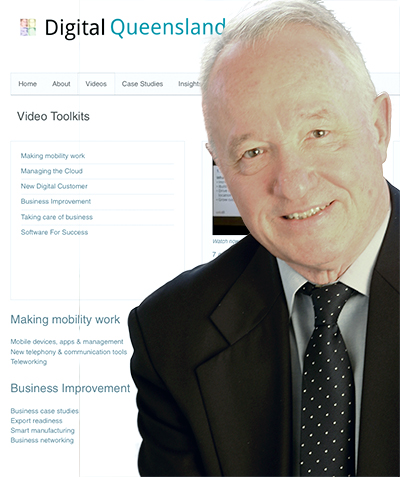Digital Business insights: What we can learn from ants
Digital Business insights by John Sheridan >>
FAMED Professor Michael Porter has highlighted the increasing disconnection between business and society. Companies have become too narrow in their view of economic value creation.
They chase short-term return for shareholders. They enforce price cuts on suppliers. They deskill and automate jobs to reduce wages. They downsize, outsource, relocate and offshore to reduce overheads...all at the expense of the society they operate and live in.
Growth and innovation in business suffers as a result. And business then becomes a major cause of social, environmental and economic problems. 
The disconnection between business and society has created the 1%.
And the disconnection has happened right in the middle of a new digital revolution that is steadily and stealthily connecting everybody up, fostering and encouraging ever more connection and collaboration.
So we witness board and management disconnection at a time of universal interconnection, two societal forces pushing in opposite directions. But only one of them is irresistible.
Google has provided universal, swift and easy access to information, shifting the power from vendor to customer, from the big to the small, from the selfish to the sharing, from the secretive to the transparent.
Businesses need to review and revaluate their narrow views, and endeavour to create economic value by creating societal value – recognising that what is good for the community is good for business. And this even includes banks.
As Michael Porter points out, all profit is not equal. Profit involving shared value helps society to advance more rapidly and allows companies to grow faster.
Business is not just about shareholder value, it is about the sustainability of shareholder value.
Farming value, not mining value. Focusing on the medium and longer-term, not short term.
Most farmers have always understood this. Value adding. Conserving, collaborating, investing and improving, applying a sustainable approach to agriculture that can be passed onto future generations.
The digital revolution pushes issues of economic value and societal value to the forefront. Into the cold light of day and the public domain.
In a revolution where the currents of change drive us towards more connection, more collaboration and more integration, our attitudes inevitably follow.
There is a slow but steady shift in attitude. Not yet for everybody, but apparent in those early adopters of digital technology, the innovators and the young digital natives.
This 20% of organisations - the agile, the smart, the informed and the adaptable – recognise opportunity when it stares them in the face.
The other 80% actually have no choice in the matter, but have failed to recognise that fact...so far. The digital currents of transformation carry them in one direction only.
Out into the digital ocean of change. They are caught in an enormous digital riptide carrying them out to sea faster than they can possibly swim in the other direction, back to the safe, solid land of the 20th century, when direction was clear, plans could be made and followed through, KPIs measured and MBAs meant something.
There is no solid land in the digital revolution. We are all at sea.
That is the intriguing thing about this revolution. We are impacted and affected no matter what we do.
The only intelligent option is to use the currents of change for personal, collective and collaborative advantage. And that means understanding what is happening. "Getting it". Making and taking time to really understand the options and opportunities, not abdicate responsibility to somebody else.
The digital revolution isn't about the froth and bubble of social media and websites. It is about the deep currents of digital disruption – more connection, more collaboration and more integration transforming the world we live in. These currents are changing all aspects of our society forever.
The major barriers and blockages to the digital revolution are nearly all human, nearly all attitudinal and therefore hard to modify and change.
Command and control is redundant. But countless managers wrestle with this new fact every day. Unsuccessfully.
Business loyalty has become hollow. Loyalty now only follows authenticity.
And millions of CEOs still face this disruptive revolution without full comprehension, unwilling to make time to understand what and why and how. "I'm too busy", they say, from the bus as it disappears over the cliff.
People are the barriers and inhibitors. As well as the innovators and inventors.
But revolutions take time. And patience is required.
You can't whip a tree and make it grow. The early adopters will adopt. But then...
For the 80% of slow followers, laggards and digital dinosaurs, a variety of approaches must be taken to explain, inform, cajole, educate, support and continue to support. And different messages are required for different groups of people.
But the decision to engage, the recognition and the understanding of opportunity and threat remains firmly in the hands of the CEO, the Mayor, the Chair and the politician.
These are the people that have to understand how wide ranging, deep and demanding this revolution really is. Most need help. Most are in key roles in our society. Embarrassed. Unwilling to admit to lack of understanding.
And they don't understand what they don't understand, and don't know what they don't know.
These "leaders" in name only are scattered across our nation - all in senior roles, in business, politics, media, government and not-for-profit organisations, all of them holding productive change back.
King Canutes. Millions of them.
This revolution involves technology (tools) AND people (users).
Technology is an enabler. But it has to be coupled with comprehensive understanding, imagination and enterprise.
And the process of change management is not like architecture where we draw a plan, then assemble inorganic elements into a structure. The digital revolution demands an approach more akin to gardening where we never really know what is going to "come up".
We have a general idea of what might be but then have to work with the reality as it emerges. Then water, fertilise, prune.
This is uncomfortable for those who think everything can be controlled. Gardening is intelligent management...not control.
The technology is the "easy" bit. But people are hard.
So all our "we will gain some real societal benefits out of this revolution" endeavours have to recognise the human component.
Software companies understand this. Systems integrators understand this. Education, explanation, training and support have to be ubiquitous.
We can't take this for granted.
Worse still (or better still), we are now entering a stage of connecting organisations, regions, states, countries, supply chains and ecosystems and that requires even more understanding and a very different collaborative approach that is inclusive and recognises the new currency of authenticity, honesty, consistency and trust.
And the traditional brokers are broken.
Industry associations, councils, governments have to seriously consider what it means to collaborate with others, and to move beyond merely talking about it, into action...because most current actions are reinforcing the status quo. Reinforcing the borders, the boundaries, protecting "their' constituents and members (Not for the good of their constituents but for their own vested interests).
Talking about collaboration and working together, and doing it are different things. There are lots of words and discussions...but little action.
This is the next "bump in the road". Get this right and there can be profound benefits in our societies. We will get there, no doubt of that, but governments and industry brokers seem to be largely stuck in 20th century architectural thinking and strategies, when landscape gardener thinking is required. Stuck in command and control when shared value is the new mantra.
Revolutions take time. And it is not easy readjusting views and viewpoints.
It seems to be especially hard for politicians and business groups and industry associations. The polarisation of all viewpoints into left and right, liberal and conservative doesn't ring true in a connected world. There are good ideas from both side and all sides. We need the best of both.
It is no longer about where the idea came from. Who cares? The issue now becomes "Is it a good idea?" measured against all the wicked problems we face as a society.
It is not about point scoring it is only about outcomes.
This is a hard new world for political parties to engage with. For them it is all about the tennis match – hitting the ball back and forth, one side to the other. They can't see how they can be both sides of the net at the same time. Yet, to deal with the wicked problems in society they must be.
It is the same thing with the way we historically organised our businesses and governments into departments to optimise the outputs of the industrial revolution.
The digital revolution demands a different structure. The wicked problems in society can only be solved by cross-departmental collaboration. The game has changed. Competition has morphed into coopetition, into shared value, into collaboration.
Most politicians have long forgotten what the idea of "public service" is about. Not all. But most. And the public has moved on. Power has shifted to the individual. And the individual's networks. "Authenticity rules. OK".
Attitudes that align with the new connected reality resonate. Others don't.
And of course, the digital revolution disrupts politics across the spectrum no matter what political persuasion or views one might have.
The digital revolution provides platforms for discussion outside of the traditional channels and supports initiatives of all kinds. Most politicians are not comfortable with this new disrupted, multimedia environment.
Their power is diminished. Control of the conversation has shifted. It is no longer enough just to be endorsed by Mr Murdoch.
And voters are far less amenable to nonsense and more amenable to common sense and authenticity, and that can come from anywhere, any side of politics, lower house or upper house.
That's why it is called "common" sense. Common sense was uncommon for quite some time but it's steadily creeping back into favour.
The digital revolution endorses the power and straight talking of the independents - the politicians who say what they really think. Because authenticity resonates with the digitally literate.
These are interesting times.
Farmers have to take a long-term view. Miners have a shorter-term point of view. We are witnessing the conflict of these perspectives on the Liverpool plains, and the jury is still out on the final verdict.
Miners can be collaborative. But they are not naturally sympathetic to the operational environment in the way farmers have always been.
Companies working collaboratively can create major improvements in the local business environment. This further reinforces and strengthens the link between an individual company's success and the community's success.
And the positive impacts that innovative businesses achieve locally can be surprising.
A NESTA report from 2009 offers some interesting insights. High growth companies represent roughly 5% of the business population but generate 50% of the new jobs. High growth companies are roughly half high-tech companies and half low-tech. The majority are at least 5 years old. These companies are disproportionately innovative and the innovation appears to cause growth.
Innovative companies grow twice as fast (in employment and in sales).
High growth companies also affect the surrounding business environment – a 5% rise in employment from high growth firms leads to a 1% increase in the surrounding region.
This is exciting. It is a network effect. And a network effect that we can leverage and implement.
A strong community or region, with capable local suppliers, organisations and institutions improves company productivity. There is greater supply chain efficiency, lower environmental impact and greater access to skills.
Companies working collaboratively can create major improvements in the local business environment. This further strengthens the link between an individual company's success and the community's success.
Opportunities to create shared value are tied closely to each company's particular business capabilities and vision. Where are the gaps? How can we fill them? We need to use the tools of the digital revolution to support collaboration and networks to build regional capacity and resources.
The first step is to help individual organisations become more productive and efficient through the optimal use of information and communication technology. Businesses can't move to the next level until they are skilled, confident and aware of the potentials and possibilities on offer – ready, willing and able.
Professor Porter suggests that businesses should incorporate a social dimension to their value proposition, to make them more sustainable versus competitors.
This will in turn help transform thinking and practice about the role of the business in society, giving rise to far broader approaches to creating value and leading to innovation, increased productivity and growth.
CEOs need to start thinking about what they do within the context of the whole region. Business isn't just about business. It is about every aspect of the society a business operates in.
The three underlying currents of the digital revolution – more connection, more collaboration and more integration provide the "climate conditions" for success.
Connection allows easy and swift access to information and knowledge.
Collaboration tools allow issues to be productively and collectively addressed. We need to build on the emerging toolkit of Linkedin, Twitter, Facebook, YouTube, email newsletters and other tools to generate regional shared value and take collaboration to the next level.
The key is always relevance. Novelty is enough to attract users but relevance is the glue that binds them.
Whose responsibility is it to think and act like this? Well, it should be the responsibility of central government, but we all know how much government suffers from the very factors Professor Porter outlined – short termism, polls and popularity, departments and departmental thinking.
So we need to drop down a level to the councils and regions that are already thinking and operating holistically anyway. When you directly engage with your "end user" every day, you have to take them seriously.
That means making connected decisions on regional strategic opportunity eg tourism attraction, job creation, startup support, training, food security, carbon reduction, ageing, collaboration etc.
That means working with councils next door. That means looking at the greater good of the region not thinking solely about what happens within the council borders.
And that needs Mayors to sit down and discuss common issues and collaboration. And make decisions. And test those decisions in the regions at the grass roots, where the feedback is meaningful.
Who will make these decisions? Politicians? Possibly. Hopefully.
But it seems to be more likely that those decisions will be made in a piecemeal manner by a wide range of individuals, organisations and businesses. That is not necessarily a problem if the pieces can connect up productively to create new collaborative, fertile territory for positive change.
Ants operate collaboratively for the good of the nest. The queen does not control what happens in the nest. She lays the eggs. She creates the resource.
The ants forage, find food and manage threats with all the "decisions" being made at the small group level. The ants collaborate to solve problems. There is no central command and control. Yet the result of collaboration at this level is remarkably successful.
Collaboration at grass roots is already happening, not just in Australia but across the planet. It is a very natural activity. Individuals and groups are collaborating to solve problems. Now we just need to scale up. And take this collaborative approach to the next level.
We can learn a lot from ants. They are successful. They have collaborated for 100 million years. And if the humble ant can manage this so successfully, surely we can.
John Sheridan is CEO of Digital Business insights, an organisation based in Brisbane, Australia, which focuses on helping businesses and communities adapt to, and flourish in, the new digital world. He is the author of Connecting the Dots and getting more out of the digital revolution. Digital Business insights has been researching and analysing the digital revolution for more than 15 years and has surveyed more than 50,000 businesses, conducting in-depth case study analysis on more than 350 organisations and digital entrepreneurs.
ends






